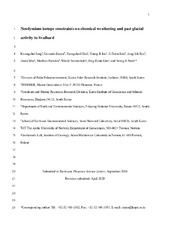| dc.contributor.author | Jang, Kwangchul | |
| dc.contributor.author | Bayon, Germain | |
| dc.contributor.author | Han, Yeongcheol | |
| dc.contributor.author | Joo, Young Ji | |
| dc.contributor.author | Kim, Ji-Hoon | |
| dc.contributor.author | Ryu, Jong-Sik | |
| dc.contributor.author | Woo, Jusun | |
| dc.contributor.author | Forwick, Matthias | |
| dc.contributor.author | Szczuciński, Witold | |
| dc.contributor.author | Kim, Jung-Hyun | |
| dc.contributor.author | Nam, Seung-Il | |
| dc.date.accessioned | 2021-02-10T13:19:23Z | |
| dc.date.available | 2021-02-10T13:19:23Z | |
| dc.date.issued | 2020-05-15 | |
| dc.description.abstract | <p>Neodymium (Nd) isotopes in leached authigenic components of marine sediments have been increasingly used as a tracer of past ocean-water masses. Despite the general assumption that the Nd isotopic composition of solutes released during chemical weathering fingerprints the source rocks on continents, preferential dissolution of easily dissolvable phases may result in significant deviations in Nd isotopic composition between the solutes and the source rocks, with potential implications for the utility of Nd isotopes in paleoenvironmental studies. Here, we present the Nd isotopic compositions of leached and detrital fractions separated from bedrock and marine sediment samples from the Svalbard archipelago. Our goal is to further understand the behaviour of Nd isotopes during chemical weathering in glacial catchments and evaluate how glacier fluctuations and associated weathering congruency may have affected the export of dissolved Nd isotope signatures to seawater.
<p>Our results confirm that terrestrial weathering on Svalbard causes considerable Nd isotopic decoupling between the leached and detrital fractions of fjord sediments (△ε<sub>Nd</sub>), resulting from the preferential dissolution of marine precipitates in glaciated catchments dominated by sedimentary rocks. We also show that the degree of Nd isotopic decoupling has fluctuated in response to climate variability on Svalbard during the Holocene, which is also as suggested by the occurrence of generally higher △ε<sub>Nd</sub> values during periods of glacier advances in sediment cores retrieved from two different fjords (Dicksonfjorden and Woodfjorden). We posit that the high △ε<sub>Nd</sub> values can be ascribed to incongruent chemical weathering of fresh rock flour produced by glacial abrasion. This finding suggests that the degree of Nd isotopic decoupling could be used as a new proxy for tracing glacial fluctuations and associated glacier-derived nutrient inputs to the marine realm. | en_US |
| dc.identifier.citation | Jang, Bayon, Han, Joo, Kim, Ryu, Woo, Forwick, Szczuciński, Kim, Nam. Neodymium isotope constraints on chemical weathering and past glacial activity in Svalbard. Earth and Planetary Science Letters. 2020;542 | en_US |
| dc.identifier.cristinID | FRIDAID 1867038 | |
| dc.identifier.doi | 10.1016/j.epsl.2020.116319 | |
| dc.identifier.issn | 0012-821X | |
| dc.identifier.issn | 1385-013X | |
| dc.identifier.uri | https://hdl.handle.net/10037/20551 | |
| dc.language.iso | eng | en_US |
| dc.publisher | Elsevier | en_US |
| dc.relation.journal | Earth and Planetary Science Letters | |
| dc.rights.accessRights | openAccess | en_US |
| dc.rights.holder | Copyright 2020 The Author(s) | en_US |
| dc.subject | VDP::Mathematics and natural science: 400::Geosciences: 450::Marine geology: 466 | en_US |
| dc.subject | VDP::Matematikk og Naturvitenskap: 400::Geofag: 450::Marin geologi: 466 | en_US |
| dc.title | Neodymium isotope constraints on chemical weathering and past glacial activity in Svalbard | en_US |
| dc.type.version | acceptedVersion | en_US |
| dc.type | Journal article | en_US |
| dc.type | Tidsskriftartikkel | en_US |
| dc.type | Peer reviewed | en_US |


 English
English norsk
norsk